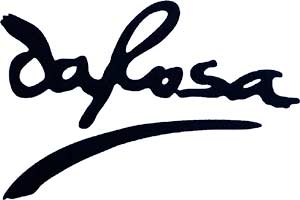
Article by Dr. Carol Damian
Large Powerful Works
The large powerful works of Eduardo daRosa speak of the human history of violence, ritual, and emotional response. Through the symbols of everyday life, he paints tragedy and despair, but the work is not dark and foreboding. The colors are pure and expressive, describing figurative subjects with intense clarity and imagination. Like wall murals of the Renaissance, mixed-media constructions and paintings narrate the human condition; now with a modern abstract vocabulary of brushwork, color and objects that shocks the viewer as much as their confrontational size and subjects.
Eduardo daRosa was born in Portugal. Disillusioned with the political and artistic climate there, he left to pursue his career in other parts of the world. In the Latin American environment, he worked in Mexico and he discoverred an affinity with the painters and their “spiritual expressiveness”. The monumental masterpieces of the Mexican muralists affected his own sense of size and scale, as well as his use of art for social comment.

In his latest figurative paintings, the unusual pinkish-orange sunsets of South Florida have brought a new range of colors to his palette that is remarkably complementary to his serious subjects. La joie de Vivre may appear at first glance to be a tribute to Matisse with its dancing figures and bold bright colors. However, this ode to life makes a totally different and contemporary comment. The subject is abortion and the right to choose or the alternative: reversion to self-imposed “hanger-surgery” and its bloody results. This red is the color of blood. Within its thick application, the paint reveals calligraphic and graffiti scrawls that contain the recognizable symbols of life and death; including a fetus floating aimlessly between the figures. The large size of the work forces a viewer-to-subject confrontation that engulfs and overwhelms with emotional intensity.

DaRosa has continued to work on his “Urban Realities” series which incorporates works, sculpture and expressive painting in tremendous constructions and installations. Peopled with life-size figures and plaster sculptures, these works express his “preoccupation with man confronted by the reality of his modern environment and its ultimate demise”. Joseph Beuys Weeps up Berlin occupies and entire wall and, like on the Berlin Wall, human figures climb in desperate efforts to escape. Beuys, the pilot and the artist, becomes the metaphor for radical art and its attempt to “start again” by sweeping away the past. “Urban Realities” encompasses subjects form the past, present and future. There is no end to the plight of man under these circumstances affording the artist continual sources of inspiration.
